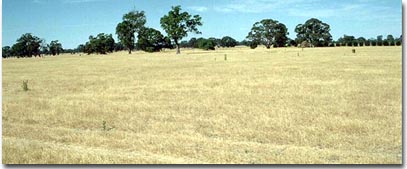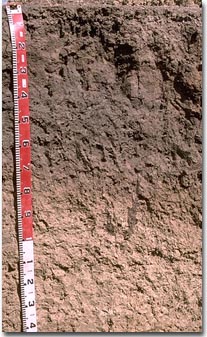Site WW16
Location: Serviceton
Australian Soil Classification: Endocalcareous-Endohypersodic, Self-Mulching, Grey VERTOSOL
Northcote Factual Key: Ug5.2
Great Soil Group: grey clay
 Site WW16 Landscape |
General Landscape Description: This soil type occurs on the flat clay plains below the low rises of the gently undulating plains. It is a variation of the soil found on the Southern Cracking Clay Plains land system (WW10 has been used to represent the whole unit on the map). Note the rise with Yellow Gum in background of photograph where the land system changes to Yellow Gum Plains and Rises.
Soil Profile Morphology:
Surface Soil
| A1 | 0-10 cm | Dark greyish brown (10YR4/2) light clay, moderate polyhedral structure (peds 20-50 mm); self-mulching surface condition (particularly evident after cultivation); strong consistence when dry; pH 8.6: |  Site WW16 Profile |
| Subsoil | |||
| B21 | 10-20 cm | Grey (10YR5/1) with slight brownish yellow (10YR6/8) mottles medium clay; moderate prismatic structure (peds 50-100 mm) parting to moderate blocky structure (peds 20-50 mm); smooth faced peds; strong consistence when dry; complete dispersion when worked; pH 8.4: Note: Within the upper subsoil there is a discontinuous bleached A2 horizon with a fine sandy clay loam texture. | |
| B22 | 20-40 cm | Medium clay; lenticular structure with some slickensides; smooth faced peds; pH 8.7: | |
| B23 | 40-60 cm | Medium clay; lenticular structure and some slickensides; smooth faced peds; complete dispersion; pH 8.8: | |
| B24 | 60-80 cm | Medium clay; smooth faced peds; pH 9.0: | |
| B25 | 80-130 cm | Medium heavy clay; strong lenticular structure (peds 10-20 mm parting to 2-5 mm); smooth faced peds; pH 9.3: | |
| B26 | 130-180+ cm | Heavy clay; some slickensides; smooth faced peds; few (2-5%) soft and hard calcium carbonate/silica and carbonate nodules. | |
Horizon | pH | Salinity | Internal Drainage | Hydro-phobicity | ||
Surface (A1 horizon) | strongly alkaline | low | non-sodic | nil | imperfectly drained3 | nil |
Subsoil (B21 horizon) | strongly alkaline | low | sodic1 | moderate2 | - | - |
Deeper subsoil (at 1 metre) | very strongly alkaline | medium-high | strongly sodic | strong | - | - |
2 Complete dispersion after remoulding.
3 Some areas may be better drained.
Key Profile Features:
- Self-mulching surface when cultivated.
- Uniform clay throughout profile.
- Uneven drainage due to gilgai micro-relief.
- Alkaline pH throughout profile.
- Strongly sodic subsoil at depth.
- Soil salinity increases at one metre depth.
- Lenticular structure and slickensides indicate high shrinking and swelling of the clay subsoil resulting in surface cracking and gilgai micro-relief.
Soil Restrictions and Management Prescriptions:
Feature | Result | Management Prescription |
| Sodic clay subsoil. |
|
|
| Alkaline subsoil. |
|
|
| Soil salinity at depth. |
|
|
Land Suitability Rating Table:
LAND USE | SUITABILITY CLASS | MAJOR LIMITING COMPONENT |
| Wheat | 2 | Climate, soil |
| Canola | 2 | Climate, soil |
| Chickpeas | 3 | Soil |
| Lentils | 3 | Soil |
| White clover seed | 3 | Soil |
| Lucerne for seed production | 3 | Soil |
| Viticulture | 3 | Soil |
| Apples | 3 | Soil |
| Potatoes | 3 | Soil |
| Carrots | 3 | Soil |
| Onions | 3 | Soil |
| Sweet corn | 3 | Soil |
| Radiata Pine | 3 | Climate |
| Blue Gum | 3 | Climate |
Land Suitability Assessment and Primary Limitations:
| Wheat | Climate | 2 | Moderate frost risk, slightly high rainfall. |
| Landscape | 1 | No major limitation. | |
| Soil | 2 | Slightly alkaline pH. | |
| Canola | Climate | 2 | Moderate frost risk. |
| Landscape | 1 | No major limitation. | |
| Soil | 2 | Slightly alkaline pH. | |
| Chickpeas | Climate | 2* | Moderate frost risk, moderate to high rainfall. |
| Landscape | 1 | No major limitation. | |
| Soil | 3# | Impeded internal drainage. | |
| Lentils | Climate | 2 | Moderate frost risk, slightly high rainfall. |
| Landscape | 1 | No major limitation. | |
| Soil | 3# | Impeded internal drainage. | |
| White clover seed | Climate | 1 | No major limitation. |
| Landscape | 1 | No major limitation. | |
| Soil | 3 | Alkaline pH. | |
| Lucerne for seed production | Climate | 1 | No major limitation. |
| Landscape | 1 | No major limitation. | |
| Soil | 3# | Impeded internal drainage. | |
| Viticulture | Climate | 2 | Moderate frost risk. |
| Landscape | 1 | No major limitation. | |
| Soil | 3# | Impeded internal drainage. | |
| Apples | Climate | 2 | Moderate frost risk, slightly high mean maximum January temperature. |
| Landscape | 1 | No major limitation. | |
| Soil | 3 | Alkaline pH. | |
| Potatoes | Climate | 2 | Slightly high mean maximum January temperature. |
| Landscape | 1 | No major limitation. | |
| Soil | 3 | Alkaline topsoil pH. | |
| Carrots | Climate | 1 | No major limitation. |
| Landscape | 1 | No major limitation. | |
| Soil | 3 | Alkaline topsoil pH. | |
| Onions | Climate | 2 | Moderate frost risk. |
| Landscape | 1 | No major limitation. | |
| Soil | 3 | Clay topsoil, alkaline topsoil pH. | |
| Sweet corn | Climate | 2 | Slightly low mean monthly temperature (October - March). |
| Landscape | 1 | No major limitation. | |
| Soil | 3# | Impeded internal drainage. | |
| Radiata Pine | Climate | 3 | Low rainfall. |
| Landscape | 2 | Wind erosion hazard. | |
| Soil | 2 | Slightly impeded internal drainage. | |
| Blue Gum | Climate | 3 | Low rainfall. |
| Landscape | 2 | Wind erosion hazard. | |
| Soil | 2 | Slightly impeded internal drainage. |
# Some areas may be better drained.
Profile Described By: Mark Imhof, Nathalie Baxter (09/01/97).


